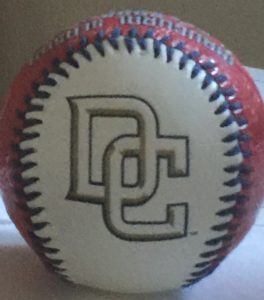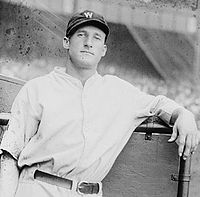October 16
Welcome to the off season! Where, between mid-October and April, most days were filled with nothing. On these days, profiles of various Senator managers, players and other movers and shakers will be briefly covered. Noteworthy trades and events will continue to be chronicled on the days they occurred.
Senator Managers
Jimmy Manning, 1901
Record as Senators manager: 61-72, .455 PCT
Teams managed:
1901 61-72, .455 Pct. 6th place, 20.5 GB
Introducing the first ever Senators manager: Jimmy Manning. Manning had previously been the owner of the Kansas City franchise of Ban Johnson’s Western League. When Johnson renamed the Western League the American League and pronounced the AL as a major league in 1901, Johnson persuaded Manning to move his Kansas City franchise to Washington.
With mostly Kansas City holdovers and a few fan favorites from Washington’s ill fated National League franchise, the inaugural edition of the Nationals got off to a respectable start. On April 26, in the Nat’s first ever game, Washington topped Philadelphia 5-1. On July 2, the Nationals found themselves at 26-22, before an 8 game losing streak dropped them below .500 for the rest of the season.
Manning was determined to build a winner. With the American League amassing a fund to assist owners in raiding the National League of players, Manning pirated the Phillies roster of pitchers “Happy” Jack Townsend and Al Orth, 3B Harry Wolverton and, the biggest prize of all, OF Ed Delahanty. Excitement was brewing in the Capital over the new players and the prospects for the 1902 season.
Not finished, at least in his mind, Manning targeted Brooklyn’s Wee Willie Keeler in the spring of 1902. When Manning attempted to assess the fund to procure Keeler, Johnson demurred. Johnson was furious that Manning paid $4000 to sign Delahanty, with some of Delahanty’s salary having to come out of Johnson’s pocket since Johnson secretly controlled some shares in the Nationals. An enraged Manning, denied from getting Keeler, abruptly resigned and sold his shares of the Washington franchise, never to be heard from again.
Senators Birthdays
While the baseball season has ended for the Senators, some seasons never end, thus today we introduce 7 more players, including 1 Hall Of Famer, who entered the Senators delivery room on October 16th:
Garland Maiers Buckeye B Oct. 16, 1897 D Nov. 14, 1975
Garland Buckeye would join the ranks of Senators One Game Wonders on June 19th of 1918 as a 20 year old rookie, when he’d pitch in 1 game, surrendering 3 hits, 6 walks and 4 runs in 2 innings, departing Washington with an ERA of 18.00.
However, Buckeye would return to the majors 7 years later, joining the Cleveland Indians. In 1925, Buckeye would go 13-8 in 30 games for the Indians, lowering his ERA to 3.65. Buckeye would remain with the Indians through July of 1928 when he was released and signed by the New York Giants.
Buckeye would also join the ranks of One Game Wonders for the Giants, his last appearance coming in mid-July, when he’d give up 6 hits, 2 walks and 6 earned runs in 3 and 2/3rds of an inning.
Henry Nicholas Cullop B Oct. 16, 1900 D Dec. 8, 1978
Nick Cullop made his major league debut in April of 1926 as a 26 year old rookie outfielder for the New York Yankees. Cullop would only appear in 2 games for the Bronx Bombers that season.
After the season, Cullop, along with Garland Braxton, were sent to the Washington Senators to complete a deal that sent Dutch Ruether to the Yankees.
Cullop would only appear in 15 games for the Senators in 1927, going 5 for 23 at the plate with 2 doubles and 1 RBI. He’d finish the 1927 season on the Cleveland roster, appearing in 32 games.
Cullop would play in 13 games for the 1929 Brooklyn Dodgers and would finish his playing career in Cincinnati, playing for the Reds in 1930 & 1931.
Leon Allen (Goose) Goslin B Oct. 16, 1900 D May 15, 1971
Hall Of Famer Goose Goslin played 18 seasons in the major leagues, coming up with the Washington Senators in 1921. He’d also play for the Detroit Tigers and the St. Louis Browns but would spend 3 different stints in Washington.
Goslin started his career as a pitcher but his impressive talent at the plate caused him to be switched to the outfield during his brief minor league stay.
Goslin would make his debut with the Senators in mid-September of 1921, hitting .260 in 14 games. During his first full season in the majors, 1922, Goslin would hit .324 with 19 doubles, 7 triples, 3 home runs and 53 RBI’s.
He’d be a mainstay in the Washington outfield through mid-June of 1930, hitting .300 or better every season from 1921 through 1928, including winning the American League batting title in 1928 with a .379 BA.
In 1929, Goslin’s hitting would drop off to .288 but he’d lead the Senators with 18 home runs and 91 RBI’s.
After 47 games in a Senators uniform in 1930, where he was hitting .271, Goslin would be traded to the St. Louis Browns for Alvin Crowder and Heinie Manush. The change of scenery must have done the Goose some good as he’d finish the season hitting .326 in 101 games for the Browns. Goslin would remain in St. Louis through 1932, hitting .328 in 1931 and .299 in 1932.
In December of 1932, Goslin would find himself headed back east as he, along with Fred Schulte and Lefty Stewart were traded to the Senators for Lloyd Brown, Carl Reynolds, Sam West and $20,000.
With the Senators in 1933 Goslin would hit .297. After the season, he’d be traded again, this time to the Detroit Tigers for John Stone. Goslin would remain in Detroit from 1934 through 1937. In his final season his BA would drop markedly, from .315 in 1936 to .238 in 1937 and he’d be given his release after the season.
Goslin would be signed one last time by the Senators for the 1938 season, but the hitting prowess he possessed as a younger man was gone-he’d only hit .158 in 38 games, playing in his last major league game in late September of 1938.
Goslin was named to the 1936 All Star Team as a member of the Tigers. He had a knack for being on the right team at the right time-he’d play in all 3 of the Senator’s World Series-1924, 1925 and 1933 and would also play in the World Series of 1934 & 1935 for the Tigers.
Goslin would lead the American League in triples with 18 in 1923 and 20 in 1925 and RBIs in 1924 when he drove in 129 runs.
An excellent writeup on Goose Goslin can be found at the SABR website: SABR Goose Goslin biography by Cort Vitty
Mark Garfield (Moxie) Manuel B Oct. 16, 1881 D Apr. 26, 1924
Another addition to the list of Senators Short Timers, 23 year old Moxie Manuel would pitch in 3 games for the 1905 Senators, leaving with no W/L record and an ERA of 5.40.
Manuel would return to the majors with the Chicago White Sox in 1908, pitching in 18 games, compiling a 3-4 record and a 3.28 ERA.
Michael William Menosky B Oct. 16, 1894 D Apr. 11, 1983
Outfielder Mike Menosky began his major league career in the short-lived Federal League, playing for the Pittsburgh Rebels in 1914 and 1915.
Purchased by the Washington Senators before the start of the 1916 season, Menosky would make it into just 11 games in 1916 when he’d hit .162.
Given a chance to play regularly in 1917, Menosky would respond by hitting .258 in 114 games. He’d not play in 1918, presumably due to World War 1, but would return to the Senators roster in 1919, hitting .287 in 116 games.
Traded to the Boston Red Sox, along with Eddie Foster and Harry Harper for Braggo Roth and Red Shannon, Menosky would play 4 years in Boston, hitting an even .300 in 1921. He’d play in his final major league game in October of 1923.
James Henry Mullin B Oct. 16, 1883 D Jan. 24, 1925
Jim Mullin played for 2 seasons, bouncing between the Philadelphia Athletics and the Washington Senators.
Debuting in June of 1904 with the Athletics, Mullin would play in 22 games for Philadelphia before being loaned to the Senators. He’d be on the Senators roster for approximately 1 month, appearing in 27 games where he’d hit .186. Mullin would be returned to Philadelphia to finish the 1904 season.
1905 would find Mullin back in a Senators uniform where he’d play in 50 games, hitting .190, appearing in his last major league game in early July.
David Michael Sisler B Oct. 16, 1931 D January 9, 2011
Dave Sisler came from a baseball family-his father George Sisler is a Hall Of Famer, who played for 15 years, including a brief stint with the Senators in 1928, and his brother Dick also played in the majors.
Dave Sisler was signed by the Boston Red Sox in 1953, making his major league debut in April of 1956. He’d go 9-8 in his rookie season with a 4.62 ERA. Sisler would remain in Boston through early May of 1959 when he was traded to the Detroit Tigers. He’d post a 7-5 mark with the Tigers in 1960.
Drafted by the expansion Senators, Sisler would go 2-8 with the “new” Senators in 1961, with a 4.28 ERA. After the the 1961 season, Sisler would be sent to the Cincinnati Reds as the infamous “player to be named later” when the Senators acquired Claude Osteen.
Sisler would end his major league career with the Reds going 4-3 with a 3.92 ERA in 1962.







